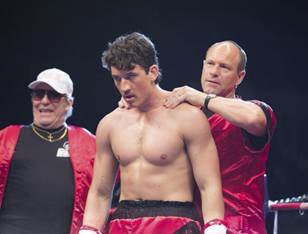Fighting the Good Fight

Courtesy of Taylor James
Bleed For This tells the story of VInny Paz, a boxer whose story could become a film classic with Raging Bull and Rocky.
November 14, 2016
The boxing movie is a cinematic trope that has been replicated, inverted and adapted countless times since the likes of “Raging Bull” and the “Rocky” franchise. It remains a popular choice because of the physical and emotional toll that a sport like boxing can take on its athletes. The athletes’ only opponents are other individuals whom they have to physically attack and weaken for 12 rounds of combat. If they lose, be it by knockout or a split-second mistake, the accountability falls solely upon their shoulders.
Such mental and physical gymnastics, especially the inner machinations of what lead to them, make for riveting film adaptations. Ben Younger’s new “Bleed For This,” a beautifully crafted, highly stylized take on the trope, is yet another step in the right direction for
the sub-genre.
The film centers around the trials and tribulations of the boxer Vinny Paz, formerly known as Vinny Pazienza, in what may be actor Miles Teller’s best performance today on screen. It follows Pazienza’s career from near irrelevance to potential career-ending injury and back into the spotlight. The film is shot with deft precision by Younger. It hinges on the performances of Teller and Aaron Eckhart, who assumes the role of Pazienza’s trainer, Kevin Rooney.
Teller disappears into his character, a quick-witted, fast talking workaholic with a thick Providence accent. The first scene sets Pazienza up skillfully. For the first fight in the film, Pazienza is late for the weigh-in. Pazienza’s father Angelo (Ciaran Hinds) feverishly dials Vinny’s number on a payphone in the weigh-in area, gets Vinny on the other line and exasperatedly asks where he is.
As it happens, Vinny is in his hotel room getting wrapped in plastic-wrap in his underwear, pedaling feverishly on a stationary bike. This opening sequence gives the viewer a point of entry into Pazienza’s psyche. He loves boxing enough to do whatever it takes to make weight for a fight — but he also loves himself enough to not care that he’s holding up the fight itself in
the process.
Eckhart serves as the film’s emotional center in a role that renders him virtually unrecognizable. Eckhart’s Rooney is a balding, pot-bellied, hard-living boxing coach in a tracksuit. Surrounded by his demons, Rooney displaces all of that negative energy into boxing.
The scenes where, despite orders from his family and medical professionals, Pazienza begs Rooney to continue training him through his life-threatening injuries are emotionally arresting to watch. The emotional interplay lays bare both characters. It’s not that Pazienza or Rooney think this is necessarily a good idea; it’s that even if they didn’t, they have no control over what they need to do in order to feel alive.
In the scenes in the hospital and on the path to rehabilitation, Teller is extraordinary. He acts like a man who is in excruciating pain, but does not particularly care — a hard balance to strike.
The movie only falters when it leans back on the crutches that are the conventions of the boxing movies of years gone by. If you strip this film of its cliches and conventions, and supplement that with more procedural and familial moments, it would be a stellar film — not just about a boxer’s life, but about life through boxing.
A version of this article appeared in the Monday, Nov. 14 print edition. Email Bradley Alsop at [email protected].























































































































































